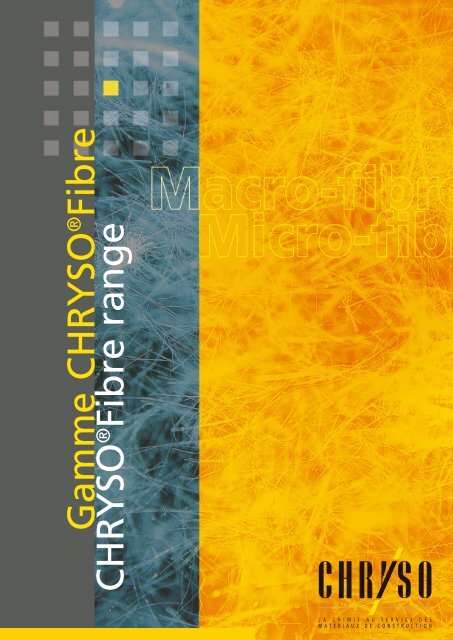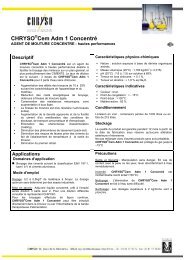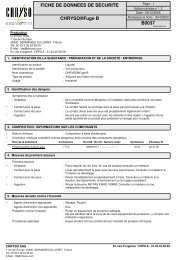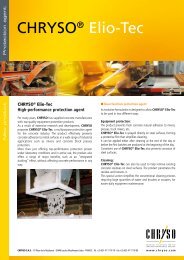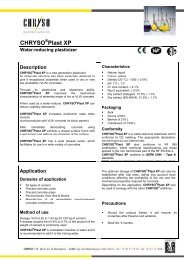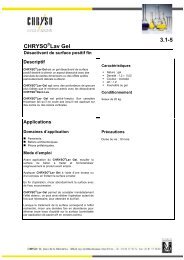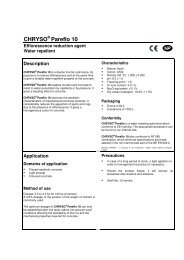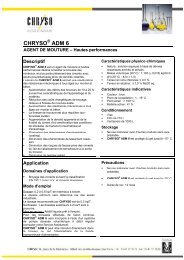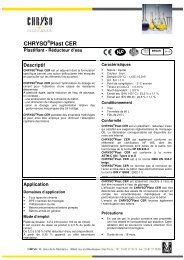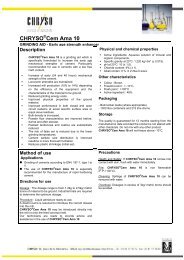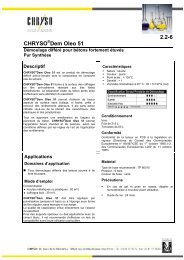Gamme CHR YSO Fibre CHR YSO Fibre range
Gamme CHR YSO Fibre CHR YSO Fibre range
Gamme CHR YSO Fibre CHR YSO Fibre range
Create successful ePaper yourself
Turn your PDF publications into a flip-book with our unique Google optimized e-Paper software.
<strong>Gamme</strong> <strong>CHR</strong><strong>YSO</strong> ® <strong>Fibre</strong><br />
<strong>CHR</strong><strong>YSO</strong> ® <strong>Fibre</strong> <strong>range</strong>
Depuis 60 ans, <strong>CHR</strong><strong>YSO</strong>, leader français et numéro trois européen<br />
du marché des adjuvants béton, a développé une expertise et un<br />
savoir-faire dans la formulation des bétons les plus techniques<br />
(comme les Bétons à Hautes et Très Hautes Résistances, les Bétons<br />
Auto-Plaçants…) et sur les chantiers les plus prestigieux.<br />
<strong>CHR</strong><strong>YSO</strong> is a major player in the world and the number one<br />
Company in France in the field of concrete admixtures. For<br />
more than 60 years, the Company has developed its expertise<br />
and know-how in the formulation of the "technical" concretes<br />
(high- and very high-performance concrete, self-compacting<br />
concrete, etc.), and its products have been used in the most<br />
prestigious construction projects.
L<br />
a généralisation des bétons dits "spéciaux" constitue la nouvelle<br />
évolution dans le monde des matériaux de construction. L’incorporation<br />
d’ajouts tels que des colorants, des éléments fins ou les différents traitements<br />
superficiels telle que la désactivation, le polissage, ou encore le bouchardage<br />
ont permis de créer de nouvelles générations de bétons.<br />
Le béton fibré est un béton dit "spécial" dont la particularité est l’incorporation<br />
de fibres synthétiques, naturelles ou métalliques.Avec leur variété de dimension,<br />
de taille, de dosage et de nature, les fibres améliorent certaines caractéristiques<br />
techniques des bétons.<br />
Pour ces deux raisons, l’utilisation de fibres est en constante évolution et se<br />
généralisera dans les années futures. Afin de toujours vous apporter des<br />
solutions et de construire ainsi, avec vous, votre gamme de demain, <strong>CHR</strong><strong>YSO</strong><br />
propose deux familles de fibres :<br />
■ Les micro-fibres : ces fibres de petite dimension, aux diamètres faibles<br />
(de 5 à 50 µm), ont pour principal effet de limiter la fissuration de retrait aux<br />
jeunes âges du béton, appelé "faïençage".<br />
■ Les macro-fibres : de dimension plus importante (diamètre de 100 à<br />
1000 µm), ces fibres ont pour but de remplacer les armatures traditionnelles<br />
dans certains produits et/ou ouvrages en béton. Elles permettent également<br />
de limiter les fissures de retrait qui apparaissent plusieurs jours, voire plusieurs<br />
semaines après la mise en place du béton.
I<br />
n the world of building materials, "special" concretes are<br />
becoming more and more common. Incorporating additives such as<br />
colouring agents/pigments, fine powders or surface treatments such as<br />
surface-retarders, polishing, or bush hammering, have thus contributed to<br />
create new generations of concrete.<br />
<strong>Fibre</strong> concrete, where synthetic, natural or metallic fibres are added to<br />
the fresh concrete, is said to be a "special" concrete. Depending on their<br />
size, dosage and characteristic, fibres may improve certain technical aspect<br />
of concrete.<br />
For these reasons, the use of fibres is in constant evolution and<br />
should become common practice in the future. We offer you solutions<br />
and will assist you to build tomorrow’s structures. <strong>CHR</strong><strong>YSO</strong> offers two types<br />
of fibres:<br />
▲ Micro-fibres: the main effect of these small diameter fibres (from 5<br />
to 50 µm), is to control cracking in recently poured concrete, also called<br />
"plastic shrinkage cracking".<br />
▲ Macro-fibres: with bigger dimensions (diameter from 100 to 1000<br />
µm), these fibres aim at substituting traditional reinforcement in concrete<br />
products and/or concrete structures. They also improve fresh concrete<br />
characteristics, when cracks appear a few days after pouring, sometimes a<br />
few weeks after.
Micro-fibres<br />
Macro-fibres<br />
Remplacement<br />
d’armature non<br />
structurelle<br />
Substitutes<br />
non structural<br />
reinforcement<br />
<strong>CHR</strong><strong>YSO</strong> ® <strong>Fibre</strong> S25<br />
<strong>CHR</strong><strong>YSO</strong> ® <strong>Fibre</strong> S40<br />
<strong>CHR</strong><strong>YSO</strong> ® <strong>Fibre</strong> S50<br />
+<br />
produits locaux spécifiques<br />
special local products<br />
Rôle<br />
anti-fissuration<br />
Crack prevention<br />
<strong>CHR</strong><strong>YSO</strong> ® <strong>Fibre</strong> UF-500<br />
+<br />
produits locaux spécifiques<br />
special local products<br />
0 0,45 0,9 3,0 +<br />
Dosage moyen (kg/m 3 de béton) / Average dosage (kg/m 3 of concrete)
Les macro-fibres ont pour rôle de remplacer les armatures<br />
passives (traditionnelles). Les macro-fibres peuvent être<br />
synthétiques (polypropylène, polyéthylène, polyvinyle, verre,<br />
carbone ou autre) ou métalliques (acier). Leurs dimensions<br />
varient de 12 à 60 mm de longueur et de 0,2 à 15 mm de<br />
diamètre.<br />
La dimension des fibres est choisie en fonction des<br />
produits à fabriquer et de la formulation béton, ainsi que la<br />
granulométrie des agrégats. Leur dosage varie selon les<br />
performances recherchées, de 1 à 50 kg/m 3 pour les macrofibres<br />
synthétiques et de 10 à 200 kg/m 3 pour les fibres<br />
métalliques.<br />
La résistance est apportée par l’adhérence et l’ancrage de<br />
la macro-fibre dans la matrice béton. Celle-ci joue alors le rôle de<br />
renfort local, uniformément réparti dans le béton, et<br />
améliore le comportement du béton aux efforts de traction.<br />
Propriétés spécifiques des bétons<br />
macro-fibrés :<br />
Macro-fibres aim at substituting passive ("traditional")<br />
reinforcement. Macro-fibres can be synthetic (polypropylene,<br />
polyethylene, polyvinyl, glass, carbon or other…) or<br />
metallic (steel). Their dimensions <strong>range</strong> from 12 to 60<br />
mm long, and from 0.2 to 15 mm in diameter.<br />
The choice of a fibre’s dimension depends on the<br />
requirements of the hardened concrete, on the formulation<br />
of concrete as well as on the particle grading of<br />
aggregates. Dosage depends on the requested<br />
performances, and <strong>range</strong>s from 1 to 50 kg/m 3 for<br />
synthetic macro-fibres and from 10 to 200 kg/m 3 for<br />
metallic ones. Depending on the amount of adherence<br />
and anchorage of the macro-fibre in the concrete<br />
matrix, the macro-fibre acts as a local reinforcement,<br />
evenly spread throughout the matrix. It improves<br />
tensile strength.<br />
Specific properties of macro-fibered<br />
concretes:<br />
<strong>Gamme</strong> <strong>CHR</strong><strong>YSO</strong> ® :<br />
<strong>CHR</strong><strong>YSO</strong> propose trois macro-fibres synthétiques de renforcement<br />
dites "structurales", à hautes résistances mécaniques :<br />
<strong>CHR</strong><strong>YSO</strong> ® <strong>Fibre</strong> S25, <strong>CHR</strong><strong>YSO</strong> ® <strong>Fibre</strong> S40 et <strong>CHR</strong><strong>YSO</strong> ® <strong>Fibre</strong> S50.<br />
Incorporées en début de malaxage, en même temps que les<br />
granulats, ces fibres se dispersent rapidement et se répartissent<br />
uniformément dans la matrice béton, formant un réseau de<br />
renforcement multidirectionnel, sans risque de corrosion en<br />
surface contrairement aux fibres métalliques. Elles limitent<br />
partiellement les fissures, et bloquent leur ouverture et leur<br />
élargissement. Le béton renforcé a ainsi une résistance postfissuration<br />
égale voire supérieure à certains bétons armés ou<br />
renforcés de fibres métalliques, en fonction du dosage. Ces<br />
performances sont obtenues grâce à une optimisation de<br />
l’adhérence fibres/béton basée sur l’ouverture des extrémités des<br />
fibres, lors du malaxage. En effet, celles-ci ont la particularité de se<br />
"fibriller" aux extrémités, agissant ainsi en trois dimensions, la<br />
surface d’ancrage s’en trouve significativement augmentée.<br />
La nature de <strong>CHR</strong><strong>YSO</strong> ® <strong>Fibre</strong> S25, <strong>CHR</strong><strong>YSO</strong> ® <strong>Fibre</strong> S40 et<br />
<strong>CHR</strong><strong>YSO</strong> ® <strong>Fibre</strong> S50 supprime les risques de corrosion et réduit<br />
l’usure du matériel (malaxeur, pompes…). Leur composition<br />
autorise l’utilisation d’accélérateurs chlorés pour une amélioration de<br />
la productivité, et leur forme, monofilamentaire et légèrement<br />
twistée, les rend compatibles avec tous types de granulats.<br />
Enfin, <strong>CHR</strong><strong>YSO</strong> ® <strong>Fibre</strong> S25,<strong>CHR</strong><strong>YSO</strong> ® <strong>Fibre</strong> S40 et <strong>CHR</strong><strong>YSO</strong> ® <strong>Fibre</strong> S50<br />
ne présentent aucun danger de manipulation pour les utilisateurs,<br />
permettant ainsi une sécurité accrue sur les chantiers.<br />
En application béton projeté, l’utilisation de ces fibres<br />
synthétiques permet de limiter les risques liés au rebond lors de la<br />
projection directe. Le rebond du béton est également limité et le<br />
rendement de la projection est ainsi amélioré de près de 30 %. Par<br />
ailleurs, face aux problèmes récurrents d’infiltrations d’eau, la pose<br />
de films d’étanchéité avant projection du béton est de plus en plus<br />
fréquente. L’utilisation des fibres <strong>CHR</strong><strong>YSO</strong> ® <strong>Fibre</strong> S25,<br />
<strong>CHR</strong><strong>YSO</strong> ® <strong>Fibre</strong> S40 et <strong>CHR</strong><strong>YSO</strong> ® <strong>Fibre</strong> S50 permet d’éliminer<br />
les risques de perforation de ces films d’étanchéité.<br />
■ Résistance en flexion :<br />
A partir d’un dosage de 2 kg/m 3 , les macro-fibres permettent<br />
d’améliorer le comportement du béton en traction/flexion. La<br />
résistance à la rupture à charge constante peut être augmentée<br />
ainsi que la ductilité du matériau (aptitude du matériau à se<br />
déformer sans rupture après la fissuration).<br />
▲ Flexural strength:<br />
From a dosage of 2 kg/m 3 , macro-fibres improve both tensile<br />
and flexural strength of concrete. Shear strength at constant<br />
load and ductility** of the material can thus be improved.<br />
(** Ductility: capacity of a material to distort without breaking<br />
after cracks have appeared).<br />
■ Résistance aux chocs durs :<br />
Les macro-fibres, grâce à leur répartition uniforme dans le<br />
matériau, permettent d’améliorer très significativement la<br />
résistance aux chocs durs, et par conséquent de réduire<br />
l’éclatement et le morcellement des éléments en béton.<br />
■ Durabilité des fibres dans une matrice béton :<br />
Certaines macro-fibres synthétiques étant soit issues de<br />
matériaux inertes, soit recouvertes d’un revêtement résistant<br />
aux attaques des sulfates, alcalins…, leurs performances ne<br />
s’altèrent pas dans le temps.<br />
▲ Resistance to hard shocks:<br />
Thanks to their capacity to spread evenly in concrete, macrofibres<br />
significantly improve resistance to hard shocks, and thus<br />
reduce rupture and parcelling out of concrete elements.<br />
▲ <strong>Fibre</strong>s’ durability in a concrete matrix:<br />
Some synthetic macro-fibres either come from inert materials,<br />
or can be covered with a coating resistant to attacks of<br />
sulphate, alkali, or else… This nature never alters the<br />
macro-fibres’ performance in time.<br />
Le dosage de <strong>CHR</strong><strong>YSO</strong> ® <strong>Fibre</strong> S25, <strong>CHR</strong><strong>YSO</strong> ® <strong>Fibre</strong> S40 et<br />
<strong>CHR</strong><strong>YSO</strong> ® <strong>Fibre</strong> S50 est entre 4 et 6 fois inférieur à celui des<br />
fibres métalliques. Cela explique la facilité de mise en œuvre<br />
d’un béton avec <strong>CHR</strong><strong>YSO</strong> ® <strong>Fibre</strong> S25, <strong>CHR</strong><strong>YSO</strong> ® <strong>Fibre</strong> S40 et<br />
<strong>CHR</strong><strong>YSO</strong> ® <strong>Fibre</strong> S50 en terme de pompabilité et d’homogénéité.<br />
<strong>CHR</strong><strong>YSO</strong> ® <strong>Fibre</strong> S25, <strong>CHR</strong><strong>YSO</strong> ® <strong>Fibre</strong> S40 et <strong>CHR</strong><strong>YSO</strong> ® <strong>Fibre</strong> S50<br />
procurent un véritable gain de temps par rapport à<br />
l’utilisation d’un treillis métallique (préparation du chantier…)
<strong>CHR</strong><strong>YSO</strong> ® <strong>range</strong>:<br />
<strong>CHR</strong><strong>YSO</strong> offers three synthetic reinforcing macro-fibres with<br />
high mechanical strength, which can replace "structural" active<br />
reinforcement: <strong>CHR</strong><strong>YSO</strong> ® <strong>Fibre</strong> S25, <strong>CHR</strong><strong>YSO</strong> ® <strong>Fibre</strong> S40 and<br />
<strong>CHR</strong><strong>YSO</strong> ® <strong>Fibre</strong> S50.<br />
Incorporated at the beginning of mixing with aggregates,<br />
these fibres scatter fast and spread evenly in the concrete<br />
matrix, thus creating a multidirectional reinforcement<br />
network, without any risk of corrosion on the surface like<br />
metallic fibres do. They partially control cracks and prevent<br />
them from opening up and expanding. Thus, depending on the<br />
dosage, reinforced concrete has a post-cracking strength<br />
equal or superior to some reinforced concrete or some<br />
metallic fibered concretes.<br />
This is mainly due to the optimisation of the adherence<br />
between fibres and the concrete matrix generated thanks to<br />
the opening of the fibres’ extremities. Indeed, macro-fibres<br />
have the particularity of "fibrillating" at their extremities and<br />
therefore acting in a three-dimensional way. The anchorage<br />
surface is significantly improved this way.<br />
The nature of <strong>CHR</strong><strong>YSO</strong> ® <strong>Fibre</strong> S25, <strong>CHR</strong><strong>YSO</strong> ® <strong>Fibre</strong> S40 and<br />
<strong>CHR</strong><strong>YSO</strong> ® <strong>Fibre</strong> S50 avoids any risk of corrosion and reduces<br />
material wearing out (mixer, pumps…). Their composition<br />
allows use with chloride accelerators in order to improve<br />
productivity. What’s more, their mono-filament and slightly<br />
twisted shape renders them compatible with any type of<br />
aggregate.<br />
Moreover, <strong>CHR</strong><strong>YSO</strong> ® <strong>Fibre</strong> S25, <strong>CHR</strong><strong>YSO</strong> ® <strong>Fibre</strong> S40 and<br />
<strong>CHR</strong><strong>YSO</strong> ® <strong>Fibre</strong> S50 are harmless on account of their<br />
composition, thus increasing security on construction sites.<br />
In shotcrete applications, the use of these synthetic<br />
fibres reduces rebound risks during direct shooting.<br />
Concrete rebound is also limited and shotcreting productivity<br />
is increased by almost 30%. What is more, setting up<br />
water repelling films before shotcreting is becoming more<br />
and more frequent due to recurrent water infiltration.<br />
Using <strong>CHR</strong><strong>YSO</strong> ® <strong>Fibre</strong> S25, <strong>CHR</strong><strong>YSO</strong> ® <strong>Fibre</strong> S40 and<br />
<strong>CHR</strong><strong>YSO</strong> ® <strong>Fibre</strong> S50 avoids perforation of these waterproof<br />
films.<br />
Caractéristiques techniques de la gamme <strong>CHR</strong><strong>YSO</strong> ® :<br />
Technical characteristics of the <strong>CHR</strong><strong>YSO</strong> ® <strong>range</strong>:<br />
Longueur<br />
Length<br />
Diamètre<br />
Diametre<br />
Couleur<br />
Colour<br />
Densité<br />
Density<br />
Dosage<br />
Dosage<br />
Point de fusion<br />
Fusion point<br />
Point d’inflammation<br />
Flamable point<br />
Résistance à la traction<br />
Tensile strength<br />
Module d’élasticité<br />
Elasticity module<br />
<strong>CHR</strong><strong>YSO</strong> ® <strong>Fibre</strong> S25 <strong>CHR</strong><strong>YSO</strong> ® <strong>Fibre</strong> S40 <strong>CHR</strong><strong>YSO</strong> ® <strong>Fibre</strong> S50<br />
25mm 40 mm 50 mm<br />
1 mm<br />
Blanche<br />
White<br />
0,92 (920 kg/m 3 )<br />
2 à 8 kg/m 3 de béton selon les applications<br />
2 to 8 kg/m 3 of concrete depending on the applications<br />
160 o C<br />
590 o C<br />
600 MPa<br />
5 GPa<br />
The dosage of <strong>CHR</strong><strong>YSO</strong> ® <strong>Fibre</strong> S25, <strong>CHR</strong><strong>YSO</strong> ® <strong>Fibre</strong> S40<br />
and <strong>CHR</strong><strong>YSO</strong> ® <strong>Fibre</strong> S50 is 4 to 5 times lower to metallic<br />
fibres’, which explains the easy pouring of concrete<br />
with <strong>CHR</strong><strong>YSO</strong> ® <strong>Fibre</strong> S25, <strong>CHR</strong><strong>YSO</strong> ® <strong>Fibre</strong> S40 and<br />
<strong>CHR</strong><strong>YSO</strong> ® <strong>Fibre</strong> S50 in terms of pumpability and<br />
homogeneity of concrete.<br />
Using <strong>CHR</strong><strong>YSO</strong> ® <strong>Fibre</strong> S25, <strong>CHR</strong><strong>YSO</strong> ® <strong>Fibre</strong> S40 and<br />
<strong>CHR</strong><strong>YSO</strong> ® <strong>Fibre</strong> S50 therefore reduces setting time<br />
compared to a concrete with a metallic reinforcement<br />
structure.<br />
Domaines d’application<br />
Applications<br />
• Chapes<br />
• Screed<br />
• Dallage de maisons<br />
individuelles<br />
• Individual housing slabs<br />
• Préfabrication<br />
• Precast<br />
• Béton de voirie<br />
• Highway concrete<br />
• Tunnels<br />
• Tunnels<br />
• Béton projeté<br />
• Shotcrete<br />
• Fondations semelles filantes<br />
• Free-running bedplate<br />
foundations<br />
• Pieux<br />
• Posts<br />
• Préfabrication<br />
• Precast<br />
Afin de mieux répondre aux attentes des différents marchés, chaque filiale <strong>CHR</strong><strong>YSO</strong> met à votre disposition des macro-fibres spécifiques.<br />
In order to answer different market requirements, each <strong>CHR</strong><strong>YSO</strong> subsidiary has specific macro-fibres at your disposition.
Le premier rôle des micro-fibres est de limiter la formation de<br />
fissure de retrait plastique. La bonne répartition des micro-fibres<br />
dans toute l’épaisseur de la matrice béton explique cet avantage.<br />
Les micro-fibres peuvent être synthétiques ou naturelles,<br />
possèdent des diamètres très faibles (< 50 microns) et sont<br />
utilisées à des dosages de 0,05 % à 0,2 %, soit 0,45 kg/m 3 à<br />
2 kg/m 3 .<br />
Les caractéristiques techniques des micro-fibres sont fonction de<br />
leur géométrie (diamètre, longueur, forme…), de leur dosage et<br />
de leur répartition dans la matrice béton.<br />
Micro-fibres are used to control cracking in recently<br />
poured concrete, thanks to their good spreading into the<br />
thickness of the concrete matrix.<br />
Micro-fibres can either be synthetic or natural, and are<br />
very small in diameter (< 50 microns). They are used<br />
in dosages of 0.05% to 0.2%, that is 0.45 kg/m 3 to<br />
2 kg/m 3 .<br />
The technical characteristics of micro-fibres depend on<br />
their geometry (diameter, length, shape, …), their dosage<br />
and the way they spread throughout the concrete matrix.<br />
<strong>Gamme</strong> <strong>CHR</strong><strong>YSO</strong> ® :<br />
<strong>CHR</strong><strong>YSO</strong> propose <strong>CHR</strong><strong>YSO</strong> ® <strong>Fibre</strong> UF-500, une micro-fibre<br />
naturelle, invisible dans le béton. Sa forme mono-filamentaire ultra<br />
souple lui permet de s’adapter à toutes les formes de granulats.<br />
Sa texture particulière lui confère une adhérence parfaite à la pâte<br />
cimentaire, et lui permet ainsi d’obtenir une très bonne résistance à<br />
l’arrachement, grâce à son excellent ancrage dans la matrice.<br />
<strong>CHR</strong><strong>YSO</strong> ® <strong>Fibre</strong> UF-500 s’oppose à la fissuration de retrait grâce<br />
à sa résistance à la traction et évite les épaufrures au décoffrage.<br />
De même, cette micro-fibre naturelle améliore la résistance des<br />
ouvrages au feu, à l’abrasion, aux chocs (surface, joints et arêtes),<br />
aux cycles gel-dégel et leur durabilité en milieu agressif (industrie<br />
chimique, bâtiment…).<br />
Le dosage de <strong>CHR</strong><strong>YSO</strong> ® <strong>Fibre</strong> UF-500 est de 450 g/m 3 de béton.<br />
Propriétés des bétons micro-fibrés :<br />
■ Résistance aux chocs et à l’abrasion :<br />
Les micro-fibres permettent d’améliorer la résistance aux chocs<br />
du béton d’environ 200 à 400 % (chute d’un poids de 3 kg d’une<br />
hauteur d’1 mètre).<br />
■ Résistance au feu :<br />
<strong>CHR</strong><strong>YSO</strong> ® <strong>Fibre</strong> UF-500, comme toutes les micro-fibres, a un<br />
point de fusion de 135°C et brûle à 360°C. A cette dernière<br />
température, le volume de la micro-fibre se réduit de 95 %. Les<br />
vides créés sont alors des vases d’expansion pour la vapeur<br />
d’eau, ce qui diminue les risques d’éclatement du béton.<br />
■ Durabilité des fibres dans une matrice béton :<br />
Certaines micro-fibres synthétiques et naturelles étant soit issues<br />
de matériaux inertes, soit recouvertes d’un revêtement résistant<br />
aux attaques des sulfates, alcalins…, leurs performances ne<br />
s’altèrent pas dans le temps.<br />
Specific properties of micro-fibered<br />
concretes:<br />
▲ Resistance to shocks and abrasion:<br />
Micro-fibres improve concrete resistance to shocks of 200 to<br />
400% (e.g. a 3 kg weight falling down from a height of 1 m).<br />
▲ Resistance to fire:<br />
The fusion point of <strong>CHR</strong><strong>YSO</strong> ® <strong>Fibre</strong> UF-500, like all microfibres,<br />
is 135°C. It burns at 360°C, and at that temperature, its<br />
volume reduces of 95%. The empty spaces thus created are<br />
used as expansion vases for steam, which reduces the risks of<br />
concrete exploding.<br />
▲ Durability of fibres in a concrete matrix:<br />
Some synthetic and natural micro-fibres either come from<br />
inert materials, or can be covered with a coating resistant to<br />
attacks of sulphate, alkali, or else… This nature never alters<br />
the micro-fibres’ performance in time.<br />
<strong>CHR</strong><strong>YSO</strong> ® <strong>range</strong>:<br />
<strong>CHR</strong><strong>YSO</strong> offers <strong>CHR</strong><strong>YSO</strong> ® <strong>Fibre</strong> UF-500, a natural micro-fibre,<br />
invisible in concrete. It is adapted to all types of aggregates<br />
thanks to its mono-filament and ultra flexible shape. Thanks to its<br />
particular texture, it sticks perfectly well to the cement paste, and<br />
thus allows a good resistance to tearing off on account of the<br />
excellent anchorage into the matrix. <strong>CHR</strong><strong>YSO</strong> ® <strong>Fibre</strong> UF-500<br />
prevents cracks thanks to its resistance to traction, and therefore<br />
avoids spalling on the formwork.<br />
Moreover, this micro-fibre improves resistance to fire, abrasion,<br />
shocks (on the surface, on the joints and spine), frost/defrost<br />
cycles and improves their durability in aggressive environments<br />
(chemical industry, construction…).<br />
The dosage of <strong>CHR</strong><strong>YSO</strong> ® <strong>Fibre</strong> UF-500 is 450 g/m 3 of concrete.<br />
Pourcentage de perte de poids<br />
Weight loss (%)<br />
Test CERIB (France) - 27/01/2006 - Dosage fibres : 1,78 kg/m 3<br />
Durée - Times (minutes)<br />
0 5 10 15 20 25 30 35 40 45 50 55 60 65 70 75 80 85 90<br />
0%<br />
-2%<br />
-4%<br />
-6%<br />
-8%<br />
-10%<br />
-12%<br />
-14%<br />
-16%<br />
-18%<br />
-20% <strong>CHR</strong><strong>YSO</strong> ® <strong>Fibre</strong> UF-500 Prisme 1 <strong>CHR</strong><strong>YSO</strong> ® <strong>Fibre</strong> UF-500 Prisme 2<br />
-22% <strong>CHR</strong><strong>YSO</strong> ® <strong>Fibre</strong> UF-500 Prism 1 <strong>CHR</strong><strong>YSO</strong> ® <strong>Fibre</strong> UF-500 Prism 2<br />
<strong>Fibre</strong>s PP Prisme 1 <strong>Fibre</strong>s PP Prisme 2<br />
-24% <strong>Fibre</strong>s PP Prism 1 <strong>Fibre</strong>s PP Prism 2<br />
Sans fibres Prisme 1 Sans fibres Prisme 2<br />
Without fibres Prism 1 Without fibres Prism 2<br />
Par ailleurs, <strong>CHR</strong><strong>YSO</strong> ® <strong>Fibre</strong> UF-500 ne nécessite pas d’ajout d’eau<br />
et n’influe pas sur le dosage en adjuvant. Le béton conserve ainsi la<br />
même fluidité que celle d’un béton non fibré.<br />
Liaison type de <strong>CHR</strong><strong>YSO</strong> ® <strong>Fibre</strong> UF-500<br />
dans une matrice de béton<br />
Microscopic view of <strong>CHR</strong><strong>YSO</strong> ® <strong>Fibre</strong> UF-500<br />
in a concrete matrix<br />
Liaison type d’une fibre polypropylène<br />
dans une matrice de béton<br />
Microscopic view of a polypropylene<br />
fibre in a concrete matrix<br />
Furthermore, <strong>CHR</strong><strong>YSO</strong> ® <strong>Fibre</strong> UF-500 does not necessitate water<br />
additions and does not affect the dosage of admixture. Concrete<br />
then keeps the same workability as a concrete without fibres.
Caractéristiques techniques de <strong>CHR</strong><strong>YSO</strong> ® <strong>Fibre</strong> UF-500 :<br />
Technical characteristics of <strong>CHR</strong><strong>YSO</strong> ® <strong>Fibre</strong> UF-500:<br />
<strong>CHR</strong><strong>YSO</strong> ® <strong>Fibre</strong> UF-500<br />
Longueur<br />
Length<br />
Diamètre<br />
Diametre<br />
Couleur<br />
Colour<br />
Nombre de fibres/g<br />
Number of fibres/g<br />
Surface cm 2 /g<br />
Surface cm 2 /g<br />
Densité<br />
Density<br />
Résistance à la traction<br />
Tensile strength<br />
Module d’élasticité<br />
Elasticity module<br />
Point de fusion<br />
Fusion point<br />
1,9 – 2 ,3 mm<br />
14 – 17 µm<br />
Blanche<br />
White<br />
1 590 000<br />
25 000<br />
1,10<br />
600 – 900 MPa<br />
8 500 N/mm 2<br />
135°C<br />
Domaines d’application • Dallages de maisons individuelles • Individual housing screeds<br />
Applications • Dallages industriels • Industrial slabs<br />
• Chapes<br />
• Slabs<br />
• Béton projeté<br />
• Shotcrete<br />
• Béton désactivé<br />
• Surface-retarded concrete<br />
• Béton de voirie<br />
• Road concrete<br />
• Tunnels<br />
• Tunnels<br />
• Préfabrication<br />
• Elements in precast concrete<br />
Afin de mieux répondre aux attentes des différents marchés, chaque filiale <strong>CHR</strong><strong>YSO</strong> met à votre disposition des micro-fibres spécifiques.<br />
In order to answer different market requirements, each <strong>CHR</strong><strong>YSO</strong> subsidiary has specific micro-fibres at your disposition.
Norvège ● Norway<br />
<strong>CHR</strong><strong>YSO</strong>, Inc. ■<br />
<strong>CHR</strong><strong>YSO</strong> UK ■ ● Pays-Bas ■ <strong>CHR</strong><strong>YSO</strong> Polska<br />
Netherlands<br />
■ <strong>CHR</strong><strong>YSO</strong> Chemie<br />
<strong>CHR</strong><strong>YSO</strong> France ■<br />
■ <strong>CHR</strong><strong>YSO</strong> Italie<br />
■ <strong>CHR</strong><strong>YSO</strong> Espagne<br />
<strong>CHR</strong><strong>YSO</strong> Portugal ■<br />
■ <strong>CHR</strong><strong>YSO</strong> Kat<br />
● ● Tunisie<br />
Maroc<br />
● Algérie<br />
Tunisia<br />
● Iran<br />
Morocco<br />
Iran<br />
Algeria<br />
Emirats Arabes Unis<br />
United Arab Emirates<br />
●<br />
● Distributeurs<br />
Distributors<br />
■ Sites <strong>CHR</strong><strong>YSO</strong><br />
<strong>CHR</strong><strong>YSO</strong> sites<br />
■ <strong>CHR</strong><strong>YSO</strong> Brasil<br />
<strong>CHR</strong><strong>YSO</strong> SAF ■<br />
<strong>CHR</strong><strong>YSO</strong> Mascareignes ■<br />
Siège social<br />
Head Office<br />
19 place de la Résistance<br />
92446 Issy les Moulineaux<br />
Cedex FRANCE<br />
Tel. 33 (0)1 41 17 18 19<br />
Fax 33 (0)1 41 17 18 80<br />
Direction Commerciale<br />
Assistance Technique<br />
Sales Direction<br />
Technical Assistance<br />
7 rue de l’Europe - Z.I.<br />
45300 Sermaises - FRANCE<br />
Tel. 33 (0)2 38 34 58 00<br />
Fax 33 (0)2 38 39 01 72<br />
<strong>CHR</strong><strong>YSO</strong> U.K. Ltd<br />
401A Mill Studio<br />
Crane Mead<br />
Ware - SG12 9PY<br />
UNITED KINGDOM<br />
Tel. 44 1920 444085<br />
Fax 44 1920 444086<br />
<strong>CHR</strong><strong>YSO</strong> Aditivos España<br />
Camino Yunclillos S/N<br />
45520 VILLALUENGA DE LA<br />
SAGRA, TOLEDO<br />
SPAIN<br />
Tel. 34 925 53 19 52<br />
Fax 34 925 53 13 36<br />
<strong>CHR</strong><strong>YSO</strong> Aditivos Portugal<br />
Rua da Fonte de Maio<br />
Edificio "Espaço"<br />
Estrada Nacional<br />
n° 249 - 3,2°E<br />
2780-596 PAÇO DE ARCOS<br />
PORTUGAL<br />
Tel. 351 21 440 58 00<br />
Fax 351 21 443 30 09<br />
<strong>CHR</strong><strong>YSO</strong> Italia<br />
Via Madonna<br />
24040 LALLIO-BERGAMO<br />
ITALY<br />
Tel. 39 035 69 33 31<br />
Fax 39 035 69 36 84<br />
<strong>CHR</strong><strong>YSO</strong> Kat<br />
Katki Malzemeleri San.<br />
Ve Tic. AS<br />
Asuroglu Kuyular Mevkii<br />
41700 DARICA GEBZE- KOCAELI<br />
TURKEY<br />
Tel. 90 262 653 91 46<br />
Fax 90 262 653 78 31<br />
<strong>CHR</strong><strong>YSO</strong> Chemie S.R.O.<br />
Sokolovska 55/81<br />
18600 PRAHA 8<br />
CZECH REPUBLIC<br />
Tel. 420 2 21 80 54 21<br />
Fax 420 2 21 80 54 14<br />
<strong>CHR</strong><strong>YSO</strong> Polska Sp.z o.o.<br />
Al. Jerozolimskie 146D<br />
02-305 WARSZAWA<br />
POLAND<br />
Tel. 48 22 570 23 50<br />
Fax 48 22 570 23 53<br />
<strong>CHR</strong><strong>YSO</strong> Mascareignes<br />
Rue des Deux Canons<br />
97490 Sainte Clotilde<br />
LA REUNION<br />
Tel. 33 (0)2 62 71 00 10<br />
Fax 33 (0)2 62 71 00 11<br />
<strong>CHR</strong><strong>YSO</strong>, Inc.<br />
10600 Highway 62 East<br />
Gate 19 - Unit 7<br />
CHARLESTOWN,<br />
IN 47111 - 0459<br />
USA<br />
Tel. 1 812 256 42 20<br />
Fax 1 812 256 42 35<br />
<strong>CHR</strong><strong>YSO</strong> Brasil<br />
Estrada de Guaxindiba S/N<br />
24722-030<br />
SÃO GONÇALO-RJ<br />
BRAZIL<br />
Tel. 55 21 3709 2334<br />
Fax 55 21 2701 0106<br />
<strong>CHR</strong><strong>YSO</strong> SAF (PTY) Ltd<br />
26 Malcolm Moodie Crescent<br />
Jet Park ext. 30<br />
1469 Boksburg<br />
SOUTH AFRICA<br />
Tel. 27 11 395 9700<br />
Fax 27 11 397 6644<br />
longrine 04 90 14 48 48 - (8862-AS-04/06) - Crédit photos : GTM Construction - Entreprise Jousselin<br />
w w w . c h r y s o . c o m


